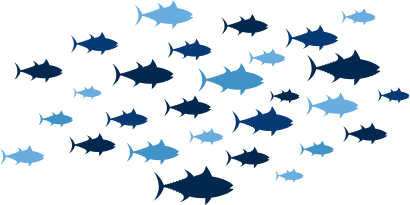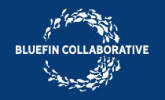OUR MISSION
SEE THE OCEAN THROUGH THE LENS OF SCIENCE.
Few fish are as highly visible as Atlantic bluefin tuna, yet their life history and status remain deeply misunderstood. Key biological questions remain unresolved or unaccepted, and the indices of abundance are inadequate. Predictably, recent stock assessments for this species have failed. This is unacceptable.
Two fundamental impediments to effective fisheries science are funding shortfalls and the difficult nature of gathering data on complex species shrouded by a vast ocean. As such, we are working to raise substantial funds to advance cooperative research and improve the assessment ‘toolkit’. Moreover, we will supplement our fund-raising and research efforts with extensive data gathering capabilities and reach.
With guidance from a diverse team of independent science advisers and a hands-on approach, we will collect vital data, fund research that will make a policy impact, and have a lasting, positive influence on the Atlantic bluefin tuna resource and fishery.
OUR MISSION
To improve the science and management for Atlantic bluefin tuna by sourcing data, funding critical research, and educating the public and decision-makers.
![]()
![]()
OUR MISSION
To improve the science and management for Atlantic bluefin tuna by sourcing data, funding critical research, and educating the public and decision-makers.

OUR VISION
From maturity to mixing and from spawning to abundance, the data we collect and the research we fund will allow for the proper management of Atlantic bluefin tuna for future generations and provide a true snapshot of the marine environment.
OUR ETHOS ON DATA GATHERING
One reason we started The Bluefin Collaborative is to bring our on-the-water expertise into the scientific arena. Our ability to gather data efficiently and effectively is the key to answering the outstanding scientific questions relevant to Atlantic bluefin tuna.
BREAKDOWN OF THE US FISHERY
When it comes to gathering data on a highly mobile and very complex species like Atlantic bluefin, the more data the better. The US fishery is spread over space and time and, by working together, these various sectors in the fishery can bring in the quantity and quality of data needed.
GENERAL CATEGORY
Vessels in this category can take bluefin by rod & reel, handline, green-stick, and harpoon gear. The summer/fall General Category fishery mainly takes place off the Northeast; the winter/spring General Category fishery mainly takes place from southern New England to the Carolinas. The sheer number of vessels in this category, coupled with its coverage over a wide range of time and space, make it a great source for data gathering.
HARPOON CATEGORY
The Harpoon Category is made up of vessels that strictly use harpoon gear for bluefin. Historically, the Harpoon Category is a summer/fall fishery from Maine through Cape Cod. This category covers areas and times that other categories do not cover and can help bring in data that may otherwise be missed.
PELAGIC LONGLINE CATEGORY
The Pelagic Longline fishery employs pelagic longline gear and takes place in the waters from east of Maritime Canada all the way to the Gulf of Mexico—and far offshore. This fleet interacts with bluefin both through a directed fishery and as incidental catch in fisheries for other highly migratory species. The Pelagic Longline fishery covers a giant swath of ocean—and generally consists of bigger and more capable vessels—meaning the data gathering potential of this category is massive.
The Charter/Headboat category is a hybrid category that allows vessels to fish on any given day under either General Category regulations or Angling Category regulations (based on the size of the first retained fish). This fishery exists throughout the waters off the US East Coast. Because Charter/Headboat category participants can catch and retain both big and small bluefin, vessels in this category can gather data that purely commercial or recreational boats cannot gather.
The Angling Category is a recreational fishery for Atlantic bluefin tuna that stretches from Maine to the Gulf of Mexico. It allows for vessels to target and keep small and medium bluefin as well as larger “trophy” fish in the over-73” commercial size range. The recreational fishery covers a massive area and is focused on retaining smaller fish—and so these vessels can get data that commercial vessels cannot get.
- COMMERCIAL
-
GENERAL CATEGORY
Vessels in this category can take bluefin by rod & reel, handline, green-stick, and harpoon gear. The summer/fall General Category fishery mainly takes place off the Northeast; the winter/spring General Category fishery mainly takes place from southern New England to the Carolinas. The sheer number of vessels in this category, coupled with its coverage over a wide range of time and space, make it a great source for data gathering.
HARPOON CATEGORY
The Harpoon Category is made up of vessels that strictly use harpoon gear for bluefin. Historically, the Harpoon Category is a summer/fall fishery from Maine through Cape Cod. This category covers areas and times that other categories do not cover and can help bring in data that may otherwise be missed.
PELAGIC LONGLINE CATEGORY
The Pelagic Longline fishery employs pelagic longline gear and takes place in the waters from east of Maritime Canada all the way to the Gulf of Mexico—and far offshore. This fleet interacts with bluefin both through a directed fishery and as incidental catch in fisheries for other highly migratory species. The Pelagic Longline fishery covers a giant swath of ocean—and generally consists of bigger and more capable vessels—meaning the data gathering potential of this category is massive. - CHARTER/HEADBOAT
-
The Charter/Headboat category is a hybrid category that allows vessels to fish on any given day under either General Category regulations or Angling Category regulations (based on the size of the first retained fish). This fishery exists throughout the waters off the US East Coast. Because Charter/Headboat category participants can catch and retain both big and small bluefin, vessels in this category can gather data that purely commercial or recreational boats cannot gather.
- ANGLING
-
The Angling Category is a recreational fishery for Atlantic bluefin tuna that stretches from Maine to the Gulf of Mexico. It allows for vessels to target and keep small and medium bluefin as well as larger “trophy” fish in the over-73” commercial size range. The recreational fishery covers a massive area and is focused on retaining smaller fish—and so these vessels can get data that commercial vessels cannot get.
FISHERIES OUTSIDE OF THE UNITED STATES
CANADA
The Bluefin Collaborative has already established a close working relationship with the ‘Southwest Nova’ fishery in Nova Scotia, Canada. These vessels naturally fish in waters that are out of reach of US fishermen and can therefore bring data into the system that will otherwise be missed.
While we are pleased to have a key part of Maritime Canada involved, we are eager to grow our coverage into other areas off Canada. Because each province is managed differently, and because vessels are generally required to fish only in their provincial waters, the only way to fully sample bluefin across their range in Canadian waters is to expand our reach.
OTHER NATIONS
The remaining major players in the Western Atlantic area are Japan and Mexico. The Japanese fleet is particularly interesting since the Pelagic Longline vessels in that fishery work in the distant waters of the Western Atlantic and sample fish that are well out of reach of any other fishermen.
In the Eastern Atlantic and Mediterranean, there are many more major players—far too many to list here. In the long run, though, The Bluefin Collaborative welcomes the participation of fishermen from all nations that interact with Atlantic bluefin tuna who are interested in improving the science for, and management of, this species.
UNDERSTAND MORE ABOUT TODAY’S ATLANTIC BLUEFIN TUNA MANAGEMENT.
Given their wide range, Atlantic bluefin tuna are managed primarily by the International Commission for the Conservation of Atlantic Tunas (ICCAT). There are currently 52 Contracting Parties. ICCAT sets national quotas and facilitates much of the assessment science for bluefin and the other ICCAT-managed fish species.
Domestically, Atlantic bluefin tuna are managed by the National Marine Fisheries Service (NMFS), an agency within the National Oceanic and Atmospheric Administration (NOAA).
For more information and details on the science of Atlantic bluefin tuna follow our news section where we compile selected papers and articles to keep our audience up to date on all the latest information.

The Bluefin Collaborative is a nonprofit, tax-exempt charitable organization (tax identification number 87-3332779) under section 501(c)(3) of the U.S. Internal Revenue Code. Donations are tax-deductible to the full extent allowable under law.
TBC Policy on Indirect Costs: It is the intent of The Bluefin Collaborative to fund only the direct costs of research projects performed by third parties. Therefore, as a policy, The Bluefin Collaborative does not fund indirect costs.


